A Novel Cellular Senescence-related lncRNA Signature for Predicting the Prognosis of Breast Cancer Patients
- PMID: 39006073
- PMCID: PMC11242350
- DOI: 10.7150/jca.96107
A Novel Cellular Senescence-related lncRNA Signature for Predicting the Prognosis of Breast Cancer Patients
Abstract
Background: Long non-coding RNA (lncRNA), a crucial regulator in breast cancer (BC) development, is intricately linked with cellular senescence. However, there is a lack of cellular senescence-related lncRNAs (CSRLs) signature to evaluate the prognosis of BC patients. Methods: Correlation analysis was conducted to identify lncRNAs associated with cellular senescence. Subsequently, a CSRL signature was crafted in the training cohort. The model's accuracy was evaluated through survival analysis and receiver operating characteristic curves. Furthermore, prognostic nomograms amalgamating cellular senescence and clinical characteristics were devised. Tumor microenvironment and checkpoint disparities were compared between low-risk and high-risk groups. The correlation between these signatures and treatment response in BC patients was also investigated. Finally, functional experiments were conducted for validation. Results: A signature comprising nine CSRLs was devised, which demonstrated adept prognostic capability in BC patients. Functional enrichment analysis revealed that tumor and immune-related pathways were predominantly enriched. Compared to the low-risk group, the high-risk group could benefit more from immunotherapy and certain chemotherapeutic agents. The expression of the 9 CSRLs was validated through in vitro experiments in different subtypes of BC cell lines and tissues. AC098484.1 was specifically verified for its association with senescence-associated secretory phenotypes. Conclusion: The CSRLs signature emerges as a promising prognostic biomarker for BC, with implications for immunological studies and treatment strategies. AC098484.1 has potential relevance in the treatment of BC cell senescence, and these findings improve the clinical treatment levels for BC patients.
Keywords: breast cancer; cellular senescence; drug therapy; immune microenvironment; lncRNA.
© The author(s).
Conflict of interest statement
Competing Interests: The authors have declared that no competing interest exists.
Figures
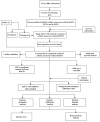
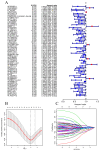
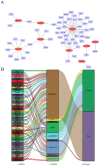
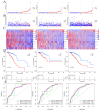
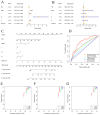



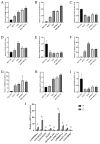
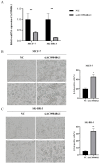
Similar articles
-
Prognostic cellular senescence-related lncRNAs patterns to predict clinical outcome and immune response in colon cancer.Front Immunol. 2024 Sep 2;15:1450135. doi: 10.3389/fimmu.2024.1450135. eCollection 2024. Front Immunol. 2024. PMID: 39355236 Free PMC article.
-
Development and validation of a novel endoplasmic reticulum stress-related lncRNA prognostic signature and candidate drugs in breast cancer.Front Genet. 2022 Aug 25;13:949314. doi: 10.3389/fgene.2022.949314. eCollection 2022. Front Genet. 2022. PMID: 36092873 Free PMC article.
-
A novel senescence-associated LncRNA signature predicts the prognosis and tumor microenvironment of patients with colorectal cancer: a bioinformatics analysis.J Gastrointest Oncol. 2022 Aug;13(4):1842-1863. doi: 10.21037/jgo-22-721. J Gastrointest Oncol. 2022. PMID: 36092325 Free PMC article.
-
Oncogenic signaling pathway-related long non-coding RNAs for predicting prognosis and immunotherapy response in breast cancer.Front Immunol. 2022 Aug 4;13:891175. doi: 10.3389/fimmu.2022.891175. eCollection 2022. Front Immunol. 2022. PMID: 35990668 Free PMC article.
-
Neutrophil extracellular traps (NETs)-related lncRNAs signature for predicting prognosis and the immune microenvironment in breast cancer.Front Cell Dev Biol. 2023 Feb 2;11:1117637. doi: 10.3389/fcell.2023.1117637. eCollection 2023. Front Cell Dev Biol. 2023. PMID: 36819091 Free PMC article.
Cited by
-
Prognostic cellular senescence-related lncRNAs patterns to predict clinical outcome and immune response in colon cancer.Front Immunol. 2024 Sep 2;15:1450135. doi: 10.3389/fimmu.2024.1450135. eCollection 2024. Front Immunol. 2024. PMID: 39355236 Free PMC article.
-
Senescence-related genes as prognostic indicators in breast cancer survival.Geroscience. 2025 Jun;47(3):2995-3006. doi: 10.1007/s11357-024-01384-w. Epub 2024 Oct 21. Geroscience. 2025. PMID: 39432147 Free PMC article.
References
-
- Sung H, Ferlay J, Siegel RL, Laversanne M, Soerjomataram I, Jemal A. et al. Global cancer statistics 2020: globocan estimates of incidence and mortality worldwide for 36 cancers in 185 countries. Ca Cancer J Clin. 2021;71:209–249. - PubMed
-
- Hernandez-Segura A, Nehme J, Demaria M. Hallmarks of cellular senescence. Trends Cell Biol. 2018;28:436–453. - PubMed
-
- Perez-Mancera PA, Young AR, Narita M. Inside and out: the activities of senescence in cancer. Nat Rev Cancer. 2014;14:547–558. - PubMed
LinkOut - more resources
Full Text Sources

